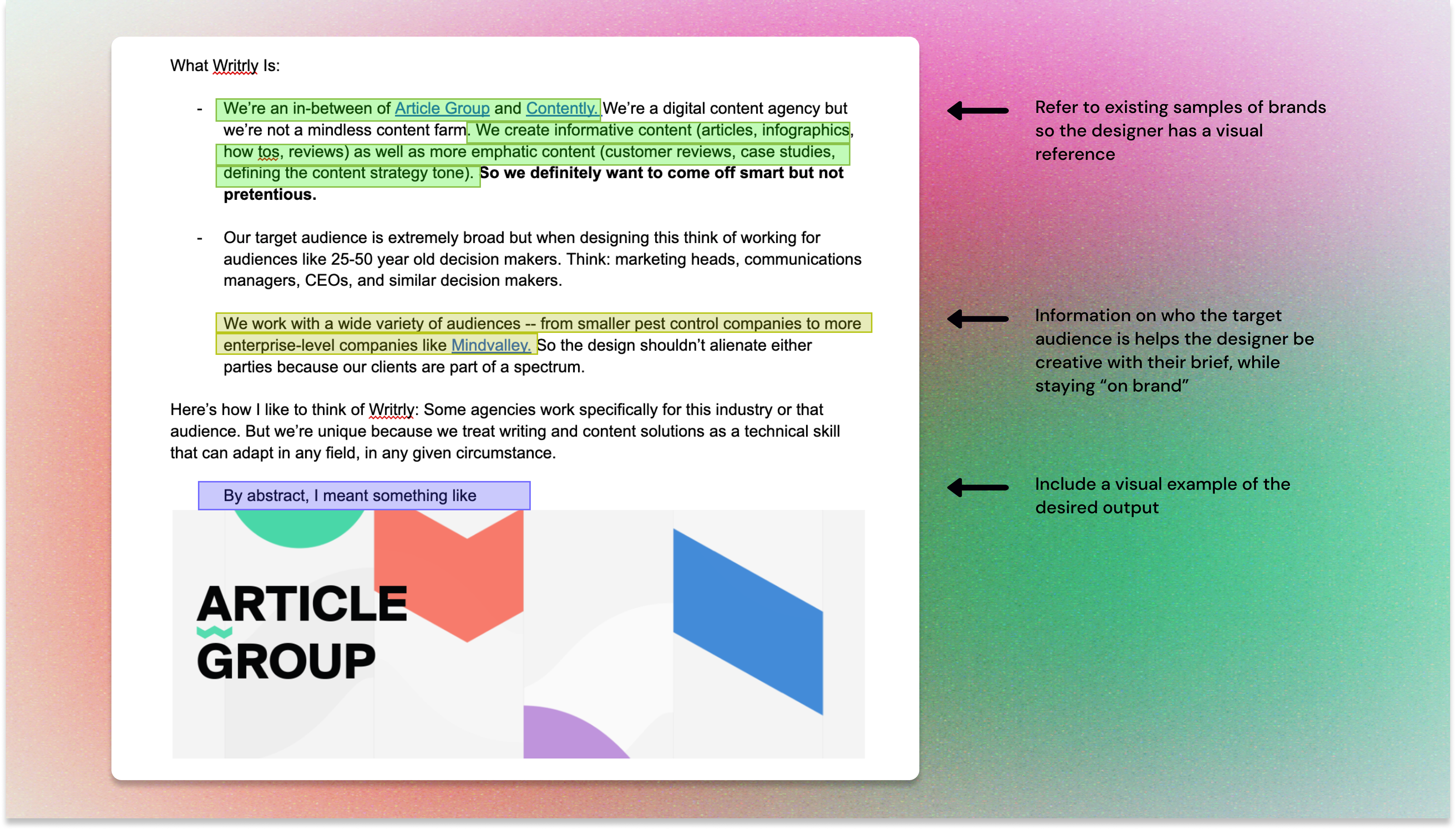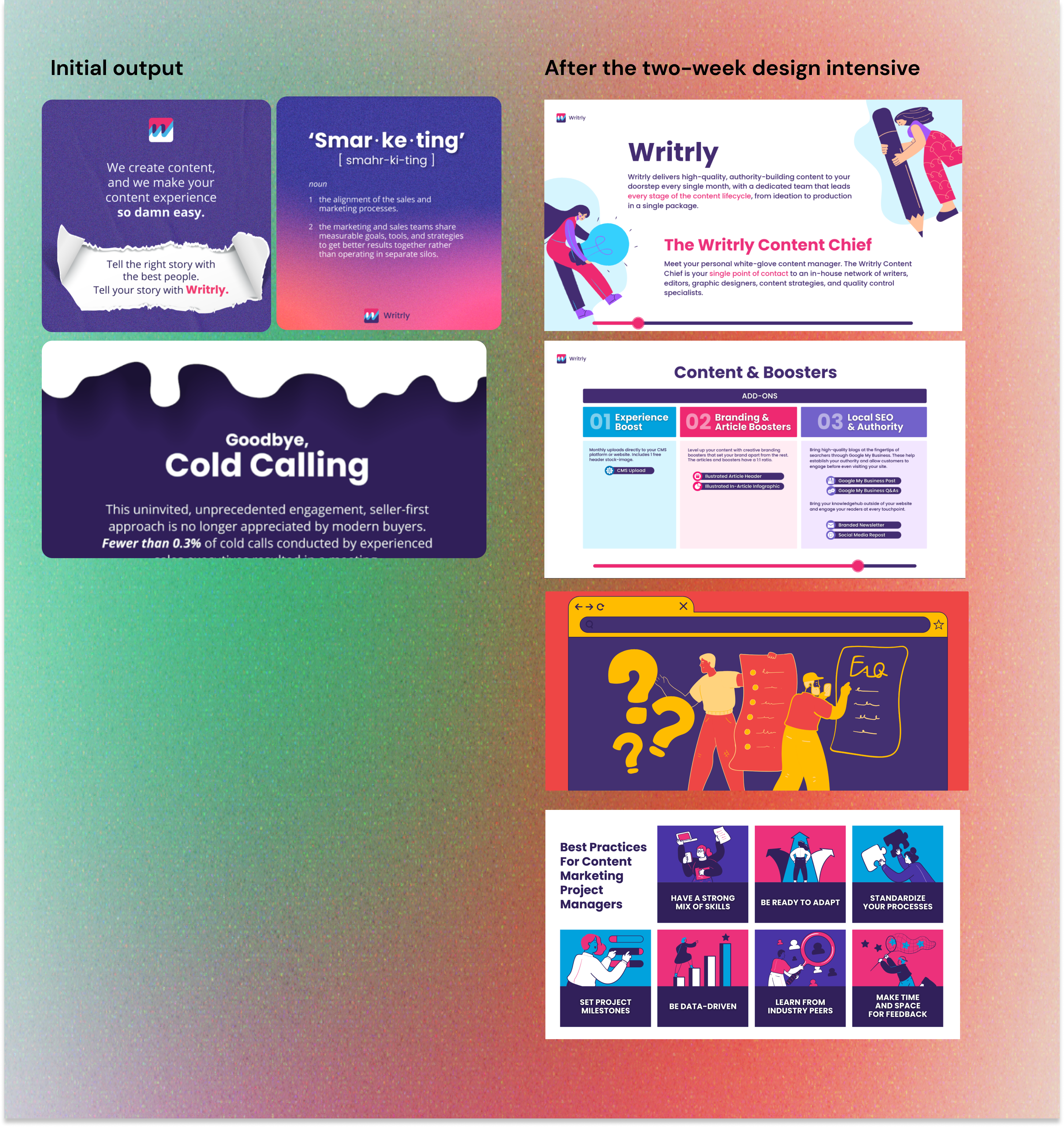A disconnected, ineffective creative team bleeds money. Problems usually look something like:
- Unending revisions and painfully long project timelines
- Messaging and positioning not reflected in the creative assets
- Wasted tools and subscriptions
- Incompatible hires with no clear ROI or high employee churn
As a bootstrapped founder, I’ve had to quickly identify signals that something is wrong, and design long-term solutions for them.
I talk about:
- Setting up systems and documentation on an organizational-level to enable seamless async collaboration, give ICs more agency, and improve project timelines
- How asking questions is my #1 problem-solving tool
Problems I’ve encountered as a team lead - and how I solved them
I’ve encountered many different problems rooted in team dynamics - here are some of them:
1) We want high-quality outputs but our hiring budget is smaller
Problem
I wanted to hire a designer for Writrly to help develop in-article infographics, images, and branding assets as part of our content strategy. I had a limited budget and top-level applicants wanted 20% more of what I was willing to pay.
How I solved it
Instead of increasing the budget, I decided to hire an applicant straight out of university who doesn’t have prior SaaS/agency experience, but has demonstrated good design technique and judgment in her portfolio.
During the hiring process, I set up a quick trial that involved creating a brand from scratch, and developing assets based on brand/style guides.
These two exercises revealed whether she can strategize, and execute according to instructions respectively. This helped me see if she has the skills necessary to improve, despite her lack of experience.
After hiring her, we went on a two-week design intensive.

I provided in-depth creative briefs at the beginning of the week. At the end of the week, I would comb through her creative output and provide specific, often technical feedback to help her develop a standard and sensibility that was close to mine.
Impact

In less than two weeks, her creative output significantly improved.
Here’s what happened after the two-week training:
- By week four she was independently creating assets based on the brief, with little to no revisions necessary
- She “upskilled” and created assets for different formats - including pitch decks, primers, and other customer-facing sales assets
2) Spending too much time doing QA to keep up with rapid content production
Problem
We scaled to doing as much as 400k words / month at Writrly. I spent 80% of my time during the week training and providing feedback to the content team. I also did QA to ensure that key messages were being communicated in the content - at scale.
I didn’t have time to move the sales-marketing needle because my time was spent on ensuring the quality of work stayed up.
How I solved it
I allocated part of the hiring budget to include a dedicated Content Editor whose sole job was QA. On top of editing articles, I asked her to create a living document for every writer. This was updated weekly and included tactical advice for improvement, based on that week’s performance.

Next, my cofounder and I spent two weeks on documentation. We developed comprehensive style guides to serve as self-serve onboarding documents for writers.
These were very in-depth guides on how to approach research and writing for different content formats such as articles, landing pages, email newsletters, and product descriptions.
The style guides provided instructions on formatting, syntax, structure, and tone. We included common mistakes and included alternative ways of writing. We also compiled multiple examples of each content format into folders.
I created a Discord channel where all new hires went: I used public chats to provide feedback. The Discord served as some sort of open database where new hires could learn quickly
Impact
- Content tone for clients and our own content became clearer and more consistent
- I went from spending 20-30 hours providing feedback and doing admin; to 5-10 a week, if at all
- Our selection pool of writers for our own content expanded because having documentation meant we no longer needed to personally invest into training time
- Our hiring pool greatly expanded. In-depth documentation opened us up to more affordable hires because majority of the training legwork was transferred onto the documentation
3) Content is undergoing several revisions because it’s not in alignment with what the stakeholder wants
Problem
Content publication was consistently delayed for 1-2 weeks for a specific client because of revisions. The client was very specific with the brand image and wanted to ensure that every content piece reflected that.
She was also keen on including key messages as the business owner in every piece of the content - sometimes requiring rewrites to accommodate these insights and messages.
How I solved it
She was increasingly getting frustrated and I went on a call with her to understand her concerns. In that call, I shared my screen and created a document that started their brand’s style guide.
Prior to the call, I had gone through previous edits she’d made on the documents and prepopulated the style guide with some of her earlier feedback to show her that I was taking her comments seriously.

I suggested a process to make content production more seamless on both our ends. In the beginning of the month, I would ask her if she had any messages or angles she wanted reflected on the content pieces - this became part of the content writers’ brief.
We regularly updated that brand-specific style guide to ensure that any and all comments she made on the documents were reflected in future content.
Impact
- We eliminated content delays completely; we met our deadlines and published on time
- The client became more trusting of our partnership and her direct involvement in the project decreased over time
- Implementing style guides for more picky clients allowed us to rotate our content team more efficiently because they didn’t need to be trained; the style guides served as their guardrails
Other problems I’ve encountered include:
Not all problems I’ve encountered led to satisfying solutions. Some led me to key insights about product growth and organic marketing:
- Influencer partners are not producing high-quality content, as per their contract
Insight: This is more reactive, but I very quickly learned that even paid influencers need very specific briefs for how to shoot content - especially if their content is more about their personality or the community, than it is about creating high-quality content.
- Marketing Manager is not producing clear ROI
Insight: “Marketing Manager” is too big for a small-scale startup; identifying a channel to go all-in on and picking a candidate with demonstrable success in that channel is better for some contexts.
I hired a Marketing Manager for an e-commerce brand but it was clear in 3 months that the candidate wasn’t a right fit because: a) she didn’t specialize in any marketing channels; b) she didn’t have clear KPIs aside from vanity metrics on socials.
How I problem-solve within teams by asking questions
Whether I’m working with in-house ICs or freelancers, the first thing I will do is ask questions to get to the root of the problem.
My goal isn’t to just address the symptoms: I want to understand what’s causing the disconnect from the IC’s part, and what I can do to bridge that gap.
This approach has helped me:
- Train newbie creatives to create high-quality outputs
- Train designers to create branded outputs on autopilot, without my feedback anymore
- Distinguish between inexperienced juniors and ICs with chronic low attention to detail
- Shift around ICs to find tasks that best match their strengths
- Help ICs develop an intimate understanding of the end-users style/tone/meta
Some questions I might ask include:
Is it the creative brief?
I ask these questions when I observe problems around misalignment with the brand identity or when the creative output is incompatible with the style for the industry, niche, or end-user.
- How did you interpret the brief? Can you explain it back to me?
- What was your understanding of the objectives? What did you think the output was for?
- Who do you think is the end-user for this creative output? Can you explain what you think they’re like to me?
- Can you give me examples of profiles/people that you think match the user profile?
- What is your understanding of the industry? Can you give me examples of creative outputs that you have seen from that industry?
Is it their standards for creative work?
I ask these questions when I observe chronic problems around delayed timelines, low-quality work, and an incompatibility with their portfolio and their actual output.
- What does your process look like when you’re doing creative work? Can you walk me through it?
- What do you think is the difference between your output and this example I’m showing?
- Can you explain why you made x, y, z creative decisions?
- How do you decide when something is “done”?
What’s the point in asking these questions?
As a lean founder my resources were limited. Time was limited. Revenue was limited. Scaling is only possible when you’re efficient with your resources.
For me, being efficient with my resources meant identifying a problem as soon as it manifests, and creating long-term solutions so that I didn’t spend more time or money putting out fires in the future.
The time investment in being curious upfront pales in comparison to the ongoing hiring and training costs, as well as revenue loss from a disconnected team.